Published Aug 3, 2012
Ten for Ward #5 – 10 Trek Novels "the Canon" Passed Over
Ten for Ward #5 – 10 Trek Novels "the Canon" Passed Over

You know, Star Trek used to be pretty simple.
Back when I was a kid, there was Star Trek: The Original Series, and the cartoon, and... well, that was pretty much it. Okay, not really. After all, there were toys, and games, and model kits, and comic books, and the occasional novel here and there. Back in those days, Star Trek was a show that aired every day after school on the local UHF channel, and it had its casual and hardcore fans (of which I was among the latter), but for a long time, no one seriously thought there’d ever be more to it. So, a lot of those old comic and novel writers were on a pretty loose leash, allowed to do all sorts of things with the Enterprise gang. After all, there was no new episode coming next week, so why couldn’t the wild adventure as told in the odd paperback really happen to Kirk and company?
With the advent of the Star Trek films and subsequent television series and the greater attention paid to “media tie-in” products like novels and comics, the writers of such “additional material” eventually found themselves operating under guidelines designed—more or less—to ensure such stories didn’t conflict with what was shown on screen. Only the editors and licensing officials at Paramount (now CBS) know how many tie-in story pitches were scrapped because they drifted too close to a film or episode in some stage of development.
Even with such safeguards in place, the occasional contradiction manifested itself, usually in the form of a TV episode or movie coming along and offering a different take on some character or plot point which already had been the focus of a comic book or novel. That’s one of the hazards of writing such material, which isn’t considered “canon” by the producers of the parent television or film property. Contradictions or “overwriting” are just going to happen. Such is life.
Does this “canceling out” of older stories told in comic or prose form make such tales any less worthy of being read and enjoyed? Oh, heck no, just like an older science fiction novel doesn’t stop being good even though real history passes it by. I still think The War of the Worlds is one of the benchmark alien invasion stories, despite us knowing that there are no Martians on Mars (assuming you believe the government disinformation campaigns). Clive Cussler’s Raise the Titanic!, written a decade before the wreck was discovered by Robert Ballard, is still a cracking adventure yarn, even though the whole thing hinges on the ship being found one in piece.
So, what about Star Trek novels that no longer “fit?” I call books like these “canon fodder,” in that they’ve been overwritten, superseded, or otherwise rendered “incompatible” due to television episodes or films subsequently added to the vast “Star Trek canon.” Some fans choose to view such tales as now taking place in some “alternate reality,” like those posited in the The Next Generation episode “Parallels” or even the 2009 Star Trek film. Me? I tend to look at the films and episodes as the “real history” of the Star Trek characters, and the tie-in stories in a vein similar to historical fiction.
Yes, I know that’s a bit geeky. Have we met?
So: Ten novels passed over by “the Star Trek Canon.” For this article, I solicited titles from readers on my blog and Facebook page. This obviously isn’t a complete list, and I wanted to make sure that every television series got some love and attention, so feel free to add your favorites in the comments section. Also, we’re not worrying about how the 2009 film might’ve jacked things around. After all, it jacked EVERYTHING around, right? With that in mind, here we go:
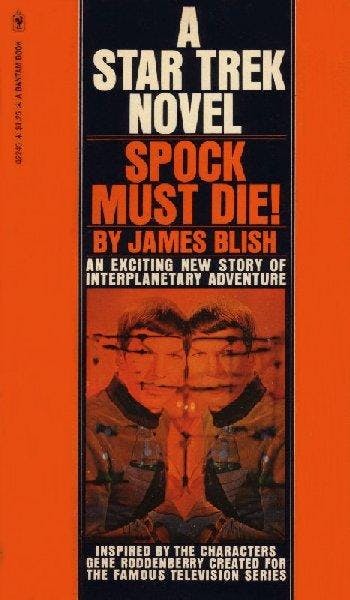
Spock Must Die! – James Blish, 1970. Not counting the “children’s book” Mission to Horatius from 1968, this was the first original Star Trek novel. A transporter accident creates a duplicate Spock, and one of them is eeeeeeeeeevil, and there’s no way for Kirk to tell them apart. With war against the Klingon Empire looming, one of the Spocks must be destroyed, but which one? At the end of the book, the Organians lay the smack-down on the Klingons, taking away the Empire’s warp drive capabilities for 1,000 years. Of course, this will be contradicted by the time Klingons show up in the The Animated Series, which came along three years after this novel’s publication.
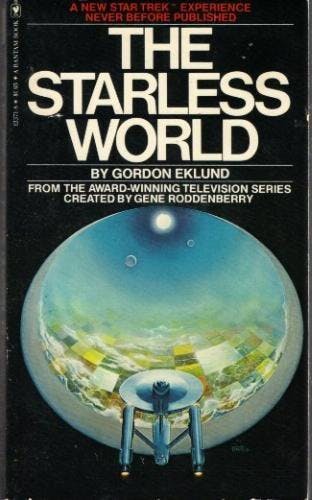
The Starless World – Gordon Eklund, 1978 (suggested by Rich Handley on Facebook). Kirk and the Enterprise discover a Dyson sphere while searching for the lost starship U.S.S. Rickover. To this point, such constructs were theoretical, and so far as Spock can determine, this is the first “real” sphere to be found. That’ll last until 1993 or so, when the TNG episode “Relics” features Picard and the Enterprise-D stumbling across a Dyson sphere of their own, thinking it’s also the first such discovery. What, didn’t they read Gordon’s book?
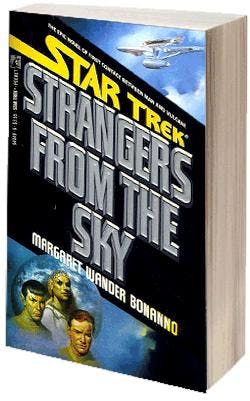
Strangers from the Sky – Margaret Wander Bonanno, 1987 (suggested by Josh Ward on Facebook). Using some nuggets of “future history” postulated in the wonderful 1980 book Star Trek: Spaceflight Chronology, this novel gives us insight into the first official contact between humans and Vulcans, while spinning a tale of the actual meeting which took place decades earlier but which remains a secret. Though 1996’s First Contact gave us the “real” dope on this historic event, my inner fanboy likes to think the earlier, clandestine meeting still could’ve taken place. Hey, it even works with the later Enterpriseepisode “Carbon Creek,” which shows us that Vulcans were on Earth in the 1950s!

Imzadi – Peter David, 1992 (suggested by Josh Ward on my blog). Still ranked as one of the most popular TNG novels, Imzadi provides us with the “inside scoop” on the relationship Will Riker and Deanna Troi shared while Riker was stationed on Betazed early in his career. Framing that is a storyline set in two other time periods, with “modern-day” Commander Riker visited by his future self, who warns him that Deanna’s life will soon be in danger and only he can save her. But, is “future” Riker tampering with time itself in his quest to save his one true love? Personal and professional developments for the TNG characters as they moved from the TV series to the films serve to derail several of the novel’s key components (Hey, no spoilers, but one hint: “Data.”), but that doesn’t change the fact that this remains a wonderful story and one of Peter David’s best Trek tales.
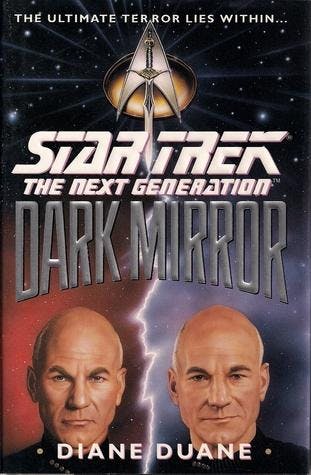
Dark Mirror – Diane Duane, 1993 (suggested by Chris Lunt on Facebook). The Enterprise-D is drawn into the same mirror universe accidentally discovered by Captain Kirk a century earlier, and Picard learns that the Terran Empire is planning an invasion of our universe! This more-advanced empire and its logical progression from what was depicted in the original TOS episode “Mirror Mirror” is fun all on its own, but Deep Space Nine, over the course of several episodes, would pretty much obliterate this take on the “mirror universe.” Subsequent novels set in the parallel reality were then required to follow the continuity established in those episodes as well as the Enterprise 2-parter, “In a Mirror, Darkly.”
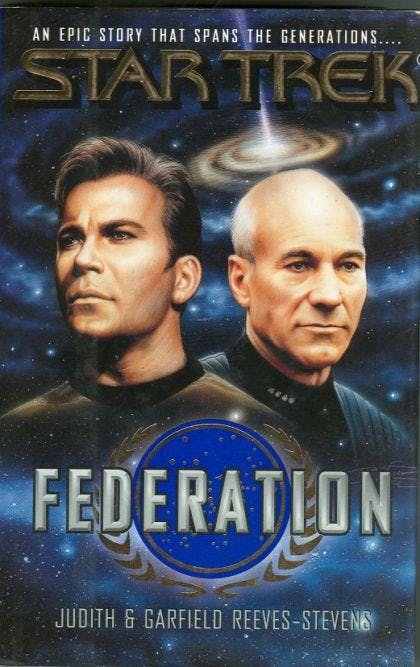
Federation – Judith & Garfield Reeves-Stevens, 1994. As the original cover says, this epic novel is “a story that spans two generations,” with parallel plotlines featuring Kirk and Picard and their respective Starships Enterprise, along with a villain who threatens both captains and their crews. It also includes “an origin story” of sorts for Zefram Cochrane, extrapolating a history for the “inventor of warp drive” based on what little information was provided in the original Star Trek episode “Metamorphosis.” First Contact, released two years later, provides a completely different take on the Cochrane character, but Federation remains a perennial fan-favorite. I still listen to the audiobook version (read by the late Mark Lenard) at least once a year.
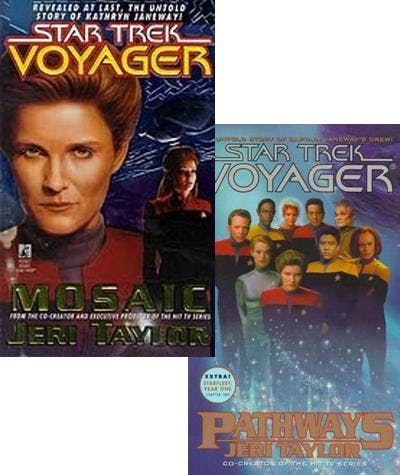
Mosaic, Pathways – Jeri Taylor, 1996 and 1998. Written by Voyager’s co-creator herself, Mosaic is the story of Captain Kathryn Janeway, while Pathways turns the spotlight on the rest of the main characters. During Taylor’s tenure on the TV series, several bits of Janeway’s personal history as conveyed in the novel also found their way into episodes (“Coda,” to name just one prime example), though after her departure such continuity hand-shaking began to wane. This was particularly true of those snippets of backstory presented in Pathways for the other characters. Despite this, both novels remain reader favorites, and still do a fine job representing some of the strongest character insight for Janeway and her crew.
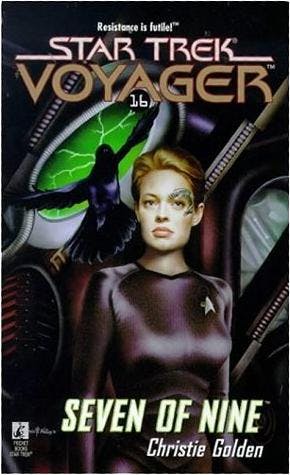
Seven of Nine – Christie Golden, 1998 (suggested by Christopher L. Bennett on my blog). As Voyager traverses a region of space which is home to several civilizations that have fallen victim to the Borg, Seven of Nine is haunted by visions and odd reminiscences. Then, she begins to relive the memories of individuals she assimilated while still part of the Borg Collective. Written as a sequel to the episode “The Raven” from Voyager’s fourth season, this idea also was later explored (in quite different fashion) in the fifth-season’s “Infinite Regress.”
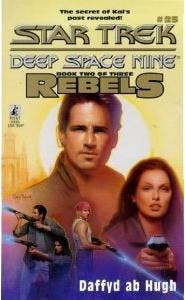
Rebels trilogy – Dafydd ab Hugh, 1999 (suggested by David Henderson on my blog). With a framing story that features the Bajoran government ordering Kai Winn to assume command of DS9 while Sisko and the Defiant are away from the station, this trilogy also gives us new insight into the Cardassian occupation of Bajor. Caught up in the turmoil of that time is a young freedom fighter named Winn Adami, and for the first time we learn the story of her struggles and battles during the occupation. Later DS9 episodes would establish a different backstory for Winn, and while both versions might work at the “broad stroke” level, the angle taken for Winn’s character on screen does set the stage for actions she’ll take during the Dominion War. You know, that whole “Pah-wraith” thing and all.
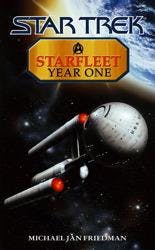
Starfleet: Year One – Michael Jan Friedman, 1999-2000. Not a novel in its original form, Year One was first presented as a serial with installments appearing in the back of Star Trek paperback novels published between August 1999 and July 2000. Providing readers with one of the first in-depth looks at Starfleet’s earliest days and adventures, the storyline was to be the first in a series of such serials, with author Friedman tackling the next “year” in sequence. Mere months after the release of the final Year One installment, Enterprise was announced as the fifth live-action Star Trek television series, and it would end up giving us a wholly different take on the same general timeframe. Subsequent novels set during this period would take their cues from the TV series, leaving Year One as something of an enjoyable “historical oddity.”
Okay, that’s a good start. Who’s got more?
The Ten for Ward backlist:
“Ten Star Trek Historical Events Which Should’ve Happened by Now” – February 2012
“Ten Favorite Star Trek Games” – November 2011
“Ten Favorite ‘Classic’ Star Trek Comics” – September 2011
“Ten Favorite ‘Old’ Star Trek Books” – June 2011
Dayton Ward is the author or co-author of numerous novels and short stories, including a whole bunch of stuff set in the Star Trek universe, and often working with friend and co-writer Kevin Dilmore. He’s also written (or co-written) for Star Trek Communicator, Star Trek Magazine, Syfy.com, and Tor.com, and is a monthly contributor to the Novel Spaces writers blog. As he is still a big ol’ geek at heart, Dayton is known to wax nostalgic about all manner of Star Trek topics over on his own blog, The Fog of Ward: http://daytonward.wordpress.com.

